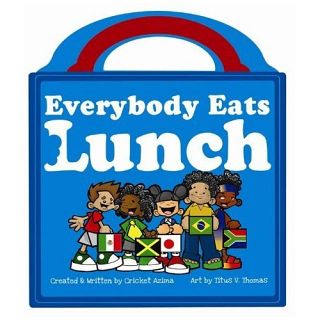As a food-lover and a parent, I've attempted to educate my kids' palettes as best I can. While I doubt that I'm succeeding to the extent of the Italians, there's certainly a lot of simple things we parents can do. Regular trips to restaurants, farmer's markets and the grocery are great ways to teach children about the selection, consumption and enjoyment of food. At home, I try to cook a wide variety of dishes using seasonal ingredients drawing from a variety of cuisines. Family dinners with the whole brood seated at the table teach your kids that meals are a great time for conversation and enjoying the company of others (and that the TV isn't a welcome dinner guest). And preparing simple recipes with a child can go a long way towards helping them appreciate food and show them that homemade food isn't that difficult and can taste better than their store-bought or processed counterparts.
 So it was with much pleasure that I recently received a copy of Cricket Azima's "Everybody Eats Lunch" (published by Glitterati Inc., 2007). The book is a welcome addition to the small, but growing, catalog of children's books about food and food culture. "Everybody Eats Lunch" features thick, rigid pages perfect for small children and sports a whimsical lunch box shape with handles on top. Content-wise, there's no real narrative (not unusual for children's books). Instead, each page of the book presents a country - Mexico, Japan, Brazil, South Africa and Jamaica - along with a lunch representative of the culture and several easy-to-follow recipes. Young children, in particular, will enjoy the recipe pages which feature colorful puzzle pieces with drawings of the dishes. These puzzle pieces can be pulled from the page (and later returned) to reveal the written recipes beneath. As a side note, I would've liked it if they could have printed the recipe on the back side of the puzzle piece since the puzzle piece was much more compact and almost functions like an index card.
So it was with much pleasure that I recently received a copy of Cricket Azima's "Everybody Eats Lunch" (published by Glitterati Inc., 2007). The book is a welcome addition to the small, but growing, catalog of children's books about food and food culture. "Everybody Eats Lunch" features thick, rigid pages perfect for small children and sports a whimsical lunch box shape with handles on top. Content-wise, there's no real narrative (not unusual for children's books). Instead, each page of the book presents a country - Mexico, Japan, Brazil, South Africa and Jamaica - along with a lunch representative of the culture and several easy-to-follow recipes. Young children, in particular, will enjoy the recipe pages which feature colorful puzzle pieces with drawings of the dishes. These puzzle pieces can be pulled from the page (and later returned) to reveal the written recipes beneath. As a side note, I would've liked it if they could have printed the recipe on the back side of the puzzle piece since the puzzle piece was much more compact and almost functions like an index card.Related Articles
My only real gripe with "Everybody Eats Lunch" is that it begs for more countries and more recipes. With only five countries covered and about one dozen recipes, it leaves the parent wanting a little more. Here's hoping that Azima will followup "Everybody Eats Lunch" with a sequel -- there's certainly sufficient material to warrant several companion volumes.
 Food-loving parents should also be aware of Amy Wilson Sanger's "World Snacks" series. This collection of books began in 2001 with the publication of "The First Book of Sushi" (published by Tricycle Press) and now features 7 titles: Let's Nosh (Jewish cuisine), Hola Jalapeno (Mexican cuisine), Yum Yum Dim Sum (Chinese cuisine), Little Bit of Soul Food (African American cuisine), Mangia! Mangia! (Italian cuisine) and Chaat & Sweets (Indian cuisine). Like "Everybody Eats Lunch", these are published as board books and each runs about 20 pages in length. Each volume gives a concise whirlwind tour through the featured cuisine. Pronunciation guides are provided (I've even learned a few new things!) and I particularly like the art which features some really clever paper collage illustrations. Coupled with the Azima volume, the Sanger books are essential reading for any children's food book collection.
Food-loving parents should also be aware of Amy Wilson Sanger's "World Snacks" series. This collection of books began in 2001 with the publication of "The First Book of Sushi" (published by Tricycle Press) and now features 7 titles: Let's Nosh (Jewish cuisine), Hola Jalapeno (Mexican cuisine), Yum Yum Dim Sum (Chinese cuisine), Little Bit of Soul Food (African American cuisine), Mangia! Mangia! (Italian cuisine) and Chaat & Sweets (Indian cuisine). Like "Everybody Eats Lunch", these are published as board books and each runs about 20 pages in length. Each volume gives a concise whirlwind tour through the featured cuisine. Pronunciation guides are provided (I've even learned a few new things!) and I particularly like the art which features some really clever paper collage illustrations. Coupled with the Azima volume, the Sanger books are essential reading for any children's food book collection.Everybody Eats Lunch is available in the following formats:
Hardcover
David Papandrew loves all foods but is especially fond of roast lamb, winter squash, stews and chocolate chip cookies. When not cooking he spends most of his time working on fanpop.com.
Related Articles
